Dual Core Snapdragon GPU Performance Explored - 1.5 GHz MSM8660 and Adreno 220 Benchmarks
by Brian Klug on March 30, 2011 4:29 PM EST- Posted in
- Smartphones
- Snapdragon
- Qualcomm
- Adreno
- MSM8660
- MDP
- Mobile
Quake 3... er... kwaak3
Quake has been a regular fixture in our mobile GPU benchmarking suite, and likewise we ran it on the MSM8660. It's starting to show its age however, as we've quickly gone from virtually unplayable framerates a little over a year ago to hitting the 60 FPS framerate cap on virtually every newish SoC.
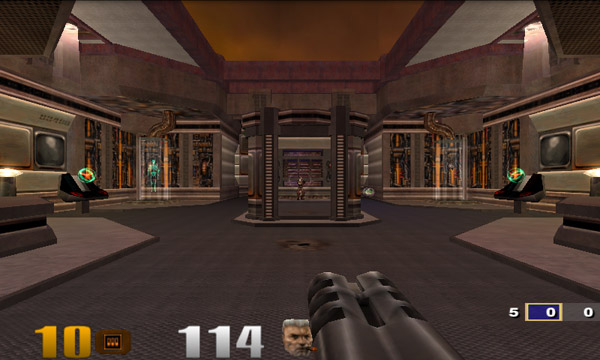
That said, it's still worth using to demonstrate performance gains, even if it isn't entirely representative of what game engines will look like going forward.
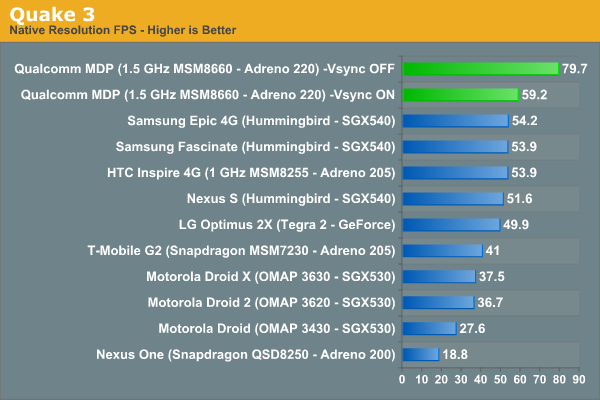
Here we can see just how obvious that framerate cap is by looking at the clustering of results right around 55-60 FPS. The cap on Qualcomm's MDP is a precise 60 Hz, but the cap on Hummingbird and others is around 56.
There's a significant jump from Adreno 200 to 205 of 2.9x, though it's likely we're capped on the Inspire 4G. I'd have numbers from the myTouch 4G as well, but it's impossible to get console to come up since the search button has been repurposed as the "Genius" button. Now I remember why I got stuck on that phone.
3DMark Mobile 2010
3DMark Mobile by Rightware is a new one for us. We've used Rightware's newer mobile GPU benchmark, Basemark, for some time now, but encountered instability on the MDP and MSM8660 and couldn't get test runs to complete and produce useable results. In addition there was some missing geometry and textures that we felt invalidated some runs.
Qualcomm provided us an APK of 3DMark Mobile 2010 which I ran on the MDP and all the other Qualcomm SoC-packing devices I had on hand. I'm not sure whether this APK was Adreno specific like I've heard 3DMM can be, but for whatever reason it didn't want to run on any other devices on hand from any other vendors. It is useful for showing generational performance differences between Adreno 200, 205, and 220, however.
The first test is Taiji and seems to be the more graphically demanding of the two, featuring some water pixel shading, normal mapping, and a complicated scene.
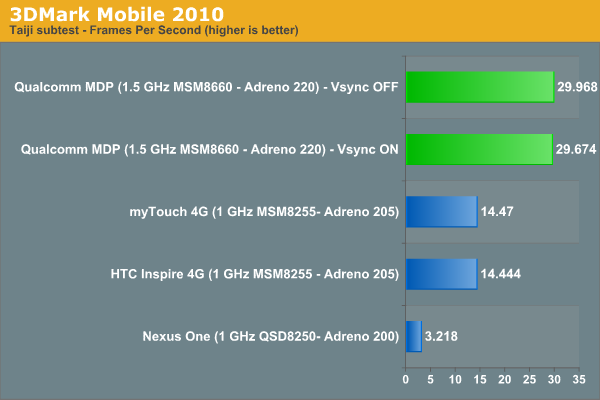
In Taiji we can see truly generational performance differences between the three Adreno GPUs. Adreno 205 is 4.5x faster than Adreno 200, and then Adreno 220 is 2.0x faster than Adreno 205. Keep in mind we're also dealing with different clock speeds and memory architectures between those last two, however.
The second test is Hoverjet, and isn't quite as demanding. Interestingly enough, Adreno 205 doesn't do quite as well here. There's now a 4.5x performance gain from Adreno 205 to Adreno 220.
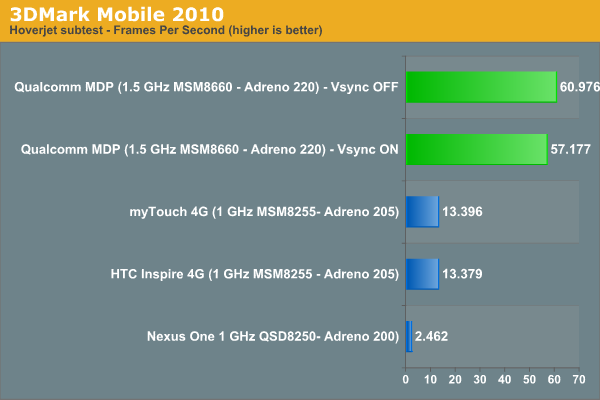
3DMark Mobile 2010 feels a bit old to us, and Rightware has indicated that Basemark will be their flagship mobile GPU benchmarking suite going forward. Once those stability issues are addressed, we'll finish running the MDP – and thus MSM8660 – and update things.
Quadrant 3D and 2D
Last and definitely least (at least in my mind) on the list is Quadrant, which has unfortunately become something of a de-facto one stop shop for benchmarking Android devices, famously spitting out one easy to digest score. Grab the pro version, and you get subtest scores. Its developers aren't very open about what all is being tested in the suite, the overall score is heavily skewed by I/O performance. Moreover the subtests themselves don't seem heavy enough for this current, much less upcoming, generation of SoCs. Benchmarking tools are rapidly evolving in the mobile space, and I expect to see far better tools quickly displace ones like Quadrant.
That said, we went ahead and ran the whole suite on the MDP just with Vsync off. I've seen some issues with Quadrant's 3D tests on Android 2.3 before, and the MDP was no exception. Again, we're going to do more CPU plus overall performance testing along with an architecture deep dive in an upcoming piece, but for now you can get a bit of that in the overall score.
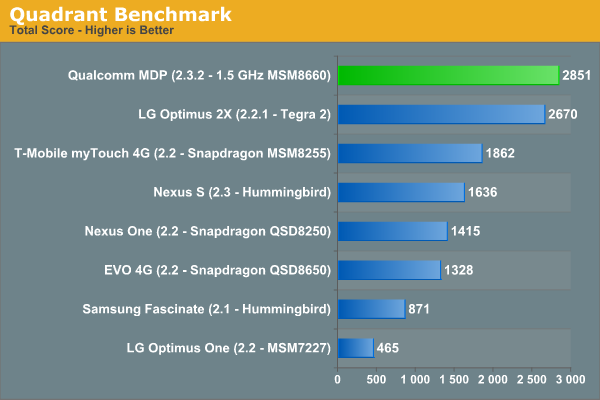
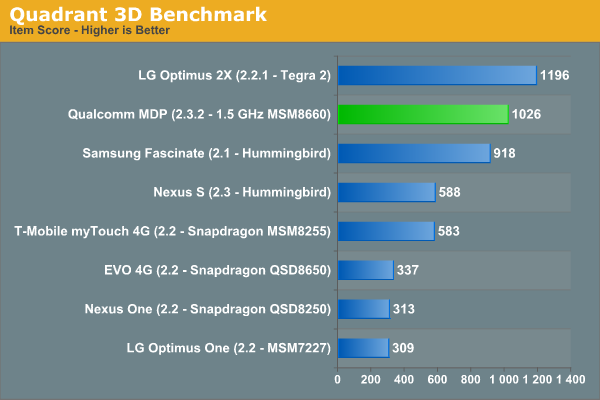
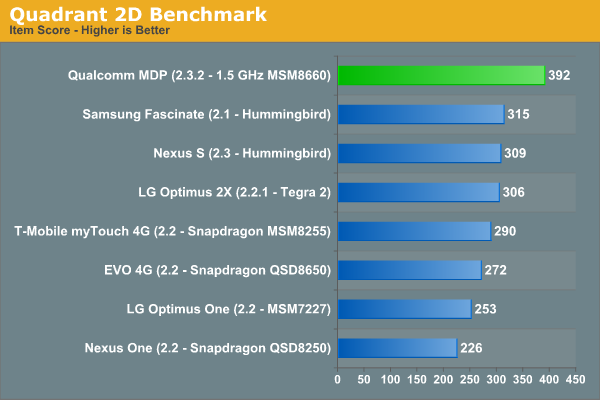
What all Quadrant is putting emphasis on with its 2D and 3D subtests is something of a mystery to me. There isn't a whole lot of documentation, but again it's become something of a standard. The 1.5 GHz MSM8660 leads in overall score and the 2D subtest, but trails Tegra 2 in the 3D subtest. If you notice the difference between Hummingbird (SGX540) from 2.1 to 2.3, you can see how Quadrant's strange 3D behavior on Android 2.3 seems to continually negatively impact performance. I saw the same odd missing texture and erratic performance back when I tested the Nexus S as I did on the MDP. Things like this and lack of updates are precisely why we need even better testing tools to effectively gauge performance.
As it is now, Adreno 220 shows anywhere from 2-5x performance gains over Adreno 205. Right now the reasons for those improvements aren't entirely clear, but we're going to do a GPU architecture deep dive relatively shortly and sort everything out. Likewise, we'll evaluate the 1.2 GHz MSM8660 and compare. Devices with the MSM8x60 aren't that far off - we're looking forward to getting our hands on the HTC Pyramid and EVO 3D which both will likely have 1.2 GHz MSM8x60 inside.
Final Words
When we first started looking at Qualcomm's Snapdragon SoCs we were impressed by their CPU performance but largely put off by the performance of the Adreno 200 GPU. The 45nm Snapdragon with the Adreno 205 GPU changed things as it roughly doubled GPU performance. The Adreno 220 brings about another doubling in GPU performance.
We'll eventually see more conservative GPU performance gains in line with Moore's Law, however for the foreseeable future these sorts of yearly generational improvements are to be expected.












70 Comments
View All Comments
metafor - Thursday, March 31, 2011 - link
Keep in mind that as you scale to higher resolutions, you won't be clipping the 60fps limit as much.So if Adreno is capable of going higher but isn't due to the fps cap, then it won't be slower at higher resolutions.
This isn't true of Egypt from what it seems though.
Alexstarfire - Thursday, March 31, 2011 - link
I would agree when you're strictly comparing GPUs, but we're almost comparing platforms in here. The problem is that you can't run most things on mobile platforms at any resolution you want. You're stuck with native resolution in just about every case.If you're trying to figure out which GPU is better then you certainly need to take resolution out of the equation. Can't really do that with mobile devices though.
You also have to remember that performance isn't necessarily linear across resolutions, especially if there is an FPS cap.
michael2k - Thursday, March 31, 2011 - link
What? 840x480 is half the iPad's resolution! 1024x768!The iPhone is 960x640, also much higher.
The iPad->iPad 2 difference of 6.4->44.8 or 17.6->57.6 tells us the iPhone 4 should be quite competitive with the dual core Snapdragon; 5.9->42 for Egypt and 50 for GL Pro 2, and at a much higher resolution to boot.
Any phone that uses the Adeno 220 and a higher resolution (like via HDMI out), will see their scores drop in half, while the iPhone should chug along without much difference.
B3an - Thursday, March 31, 2011 - link
How can the iPhone 4 remotely compare? Dont you not mean iPhone 5?Because the Motorola Atrix 4G has about the same screen res (540 x 960) yet it performance more than 2x as well as iPhone 4 in most benches. The Atrix's CPU and GPU are not even as fast as this new Scorpion SoC.
michael2k - Thursday, March 31, 2011 - link
You're right, I meant A5 on the iPhone 5.kade1878 - Saturday, April 2, 2011 - link
So lets compare the iPhone 4 to the Motorola Atrix 4G:iPhone: 960x640 = 614400
Atrix: 960x540 = 518400
So the ratio is ~1.19 or the iPhone 4 has 19% more Pixels than the Atrix.
Now compare that to the Benchmark result:
iPhone: 5.9 fps x 614400 pixels/frame = 3.624.960 pixel/s or ~3.6 MPixel/s
Atrix: 18.7 fps x 518400 pixels/frame = 9.694.080 pixel/s or ~9.7 MPixel/s
flipside101 - Saturday, April 2, 2011 - link
its slightly off topic but does anyone hve a handle on why no one else is using the PowerVR SGX543MP2 . its not apple tech but is it possible that they have an exclusive license ?ta
dagamer34 - Saturday, April 2, 2011 - link
TI and Samsung are the only other major companies besides Apple that usually use PowerVR chips. This year, Samsung stuck an ARM-based GPU into their chip, the Exynos (ARM GPU is the Mali 400) and Ti's OMAP 4430 has so far only been used in the Blackberry Playbook. All smartphone uses of the OMAP 4xxx platform are to be launched in the 2nd half of this year.GnillGnoll - Wednesday, April 6, 2011 - link
I'm sure Intel and Renesas would disagree with your definition of "major companies", among others. And the LG Optimus 3D smartphone (with OMAP4430) will be available by the end of the month.Renesas announced a SoC with SGX543MP2, so it's certainly not Apple exclusive tech.
scofflaw - Wednesday, March 30, 2011 - link
The original MDP8655 which I have has VEE display backlight control which when enabled can really lower the battery drain when running certain apps. Does this new MDP8660 have it as well?